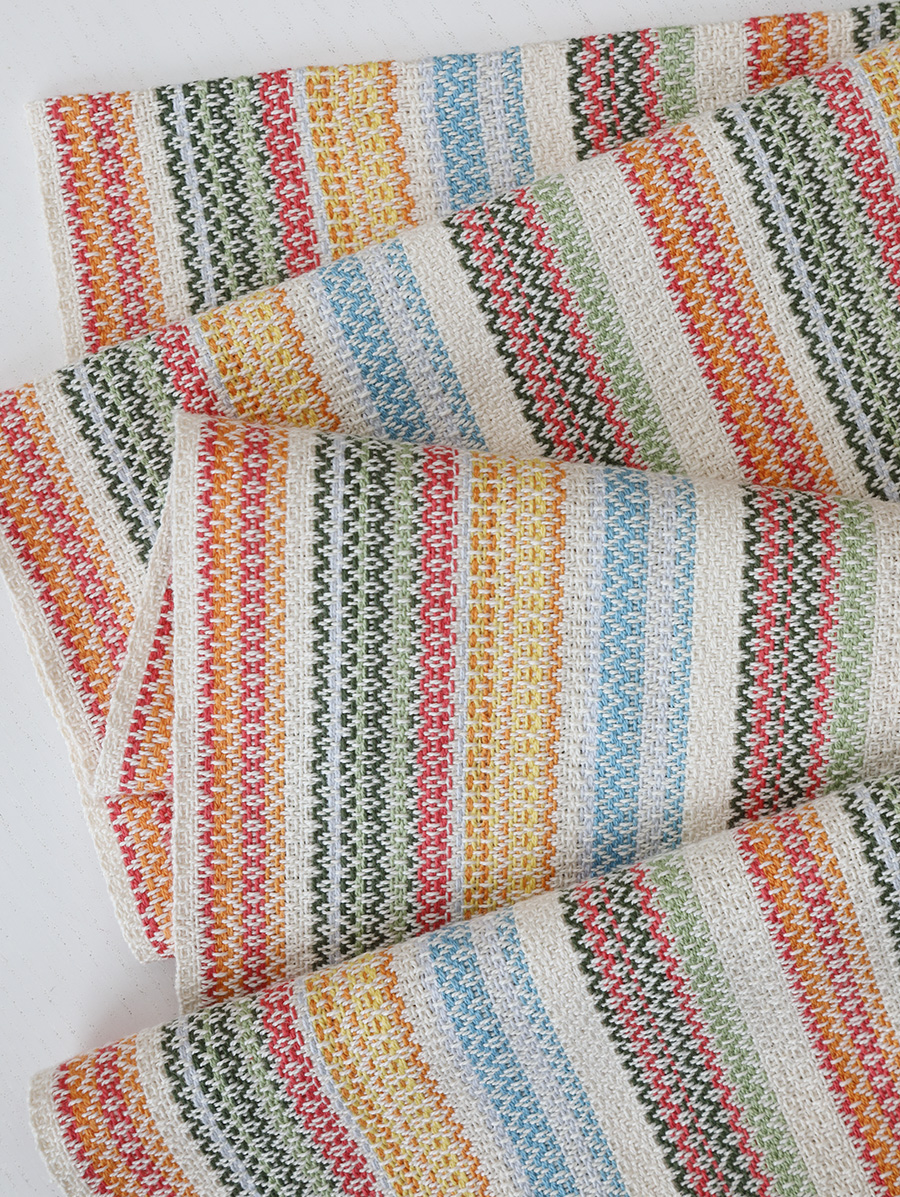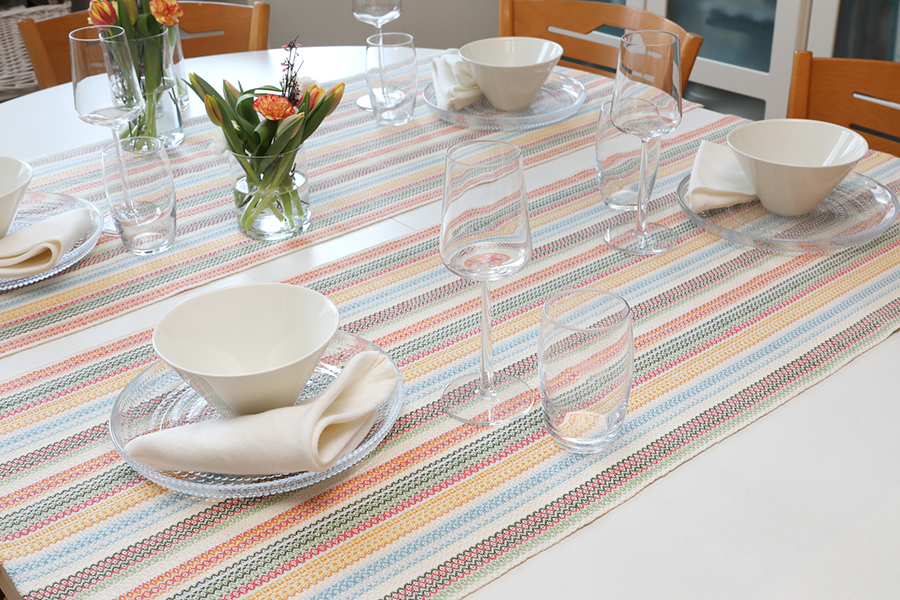What if we would create the whole warp with random stripes and they hit unplanned spots in the threading. An easy and fast model for which you could use all kinds of colours. Based on the idea, we planned the pattern into the table runners, but randomness also needed a great deal of reflection.
| The warp | Cotton 8/2, tex 74×2, 1 kg = approx. 6 800 m |
| Warp | width 56,4 cm the sett 8 ends/cm and occasionally 16 ends/cm number of warp ends 604 amount of yarn needed 380 g |
| Length | 4,3 m |
| Reed | 1 per dent in a 80-dent reed and occasionally 2 per dent (80/1 and occasionally 80/2) metric |
| Structure | Twill |

THREADING
The sections with double ends are marked on the threading. At those points, thread the two ends in the same heddle and sley in the same dent. The reed is number 80/10 (80 ends per 10 cm).
N.B! If you want to use more spaced reed number 40/10 (40 ends per 10 cm), do not thread two threads in the same heddle, but each thread on its own heddle. Another option is to change the threading so that you get an even amount of yarn at the points between the double threads. With a number 80/10 reed the pattern becomes clearer.
Weave with floating selvedges.

INSTRUCTIONS FOR WINDING THE WARP
Before winding the warp, make a colour pattern by turning the threads into stripes around the cardboard. Based on this, design the stripes for one repeat of the threading. One repeat has 150 yarns, of which 51 are double = a total of 201 yarns. In this warp, the stripes are between 1 and 18 threads in the width. Repeat the pattern 3 x = 603 threads. Add 1 thread to the end to the end for balance (not necessary).
Colour order for this warp was:
6 threads natural white
5 ” warm rose
10 ” orange
5 ” warm rose
4 ” orange
6 ” natural white
4 ” dark green
4 ” grey
6 ” dark green
3 ” light green
7 ” dark green
4 ” light green
2 ” dark green
10 ” warm rose
3 ” natural white
3 ” grey
1 ” yellow
*
2 ” orange * repeat 3 x *
2 ” yellow
*
2 ” orange
7 ” yellow
4 ” orange
5 ” natural white
5 ” grey
15 ” light blue
6 ” grey
4 ” light blue
18 ” natural white
3 ” dark green
4 ” warm rose
2 ” dark green
1 ” warm rose
6 ” dark green
4 ” warm rose
14 ” light green
6 ” natural white
Repeat 3 x in total (= 201 x 3 = 603 threads)
+ 1 natural white thread to the end
AMOUNT OF WARP YARN NEEDED, length 4,3 m
Cotton 8/2, tex 74×2, 1 kg = approx. 6 800 m,
Garnhuset i Kinna (GH) and Bockens (B)
unbleached = natural white (GH) 85 g
8272 (GH) dark green 57 g
8238 (GH) warm rose 57 g
105 (B) orange 55 g
2030 (B) yellow 27 g
8278 (GH) grey 34 g
1440 (B) green 40 g
8225 (GH) light blue 34 g
380 g in total

Table runners
Size 48 x 110 cm, 2 pcs
THE WEFT
Cotton 8/2, tex 74×2, 1 kg = approx. 6 800 m
unbleached 204 g = approx. 80 g for one meter
WEAVE according to the treadling order using natural white cotton weft. The sett is 10 – 11 threads/cm.
Weave 260 cm for two table runners. The size of the fabric off the loom was 51 x 255 cm. Measure the middle of the fabric and sew a 3-step zigzag at the ends of the table runner pieces. Then cut the clothes apart. Sew the hems by hand. Finished height of the hem is 1 cm.
Size of the table runner cloth is 51 x 120 cm and after wet-finishing 48 x 110 cm.
First wash by hand 40 – 60oC, in the future you can also wash in a machine.

Kitchen towel
Size 50 x 53 cm
THE WEFT
Linen 16/2, tex 103×2, 1 kg = approx. 4 900 m
unbleached 60 g = approx. 100 g for one meter.
WEAVE according to the treadling order 60 cm using unbleached linen weft. The sett is 8 – 9 threads/cm.
Sew the hems by hand. Finished hight of the hem is 1 cm.
Crochet the hanging loop with double cotton thread and sew it in its place with hand.
First wash by hand 40 – 60oC, in the future you can also wash in a machine.



